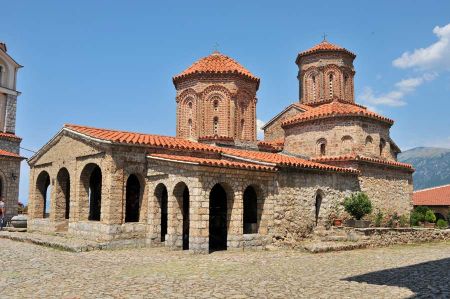Shortly before the border to Albania - Sveti Naum
- Written by Portal Editor
Coming from Ohrid, we followed the shore road along Lake Ohrid, making a short stop here and there, which also took us to the "Museum on the Water", a prehistorically reconstructed pile-dwelling settlement.
Shortly before the complex monastery park, which is only a few hundred meters from the border with Albania, we parked the car and were immediately approached by a boat driver who offered a ride across the lake to the monastery. A good opportunity to take photos, we thought, and a really acceptable price was quickly negotiated. So a little later we set off towards the monastery in the swaying boat.
Naum himself is buried in the monastery
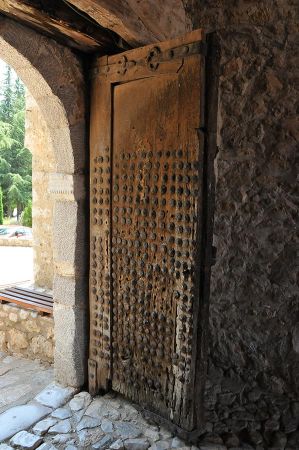 The Sveti Naum Monastery was founded around 895 by Saint Naum with the support of the Bulgarian Tsars Boris I and Simeon I. After the saint's death on December 23, 910, the monastery was dedicated to him and renamed accordingly; Naum himself is buried in the monastery. Saint Naum, also called Naum Ohridski or Naum Preslawski, was a student of Saints Cyril and Methodius and, like them, was involved in the creation of the Old Church Slavonic written language. Together with Saint Kliment of Ohrid, he was one of the monks who supported Methodius in his mission to the Great Moravian Empire:
The Sveti Naum Monastery was founded around 895 by Saint Naum with the support of the Bulgarian Tsars Boris I and Simeon I. After the saint's death on December 23, 910, the monastery was dedicated to him and renamed accordingly; Naum himself is buried in the monastery. Saint Naum, also called Naum Ohridski or Naum Preslawski, was a student of Saints Cyril and Methodius and, like them, was involved in the creation of the Old Church Slavonic written language. Together with Saint Kliment of Ohrid, he was one of the monks who supported Methodius in his mission to the Great Moravian Empire:
“...The honorable and great father Naum grew up in Moesia, and according to the upbringing given him by his noble parents, he considered nobility and wealth and all that as chaff, and joined himself to the apostle-like Constantine the Philosopher and his brother Methodius those who wandered and taught the Moesian and Dalmatian people followed them everywhere, even to ancient Rome..."
The monastery is a UNESCO World Heritage Site
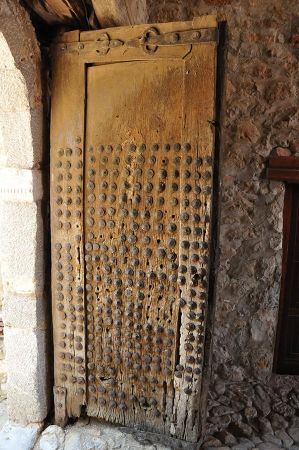 In 1870 a fire almost completely destroyed the monastery, only the monastery church was spared. The current facility was built in the following years. After Serbia's conquest of the region during the Balkan War of 1912, a residence of the Serbian king and the church of Saint Ivan Vladimir were built near the monastery. From 1913 to 1925 the monastery belonged to Albania. Ahmet Zogu, who seized power in Tirana with Yugoslav help in December 1924, ceded it to the Kingdom of Serbs, Croats and Slovenes as a thank you for their support. The monastery is now a UNESCO World Heritage site along with the city of Ohrid, Lake Ohrid and its surroundings. Due to its historical significance and beautiful location, it is one of the most popular tourist destinations in Macedonia, which would certainly become even more popular with more cleanliness and less waste disposal into the environment.
In 1870 a fire almost completely destroyed the monastery, only the monastery church was spared. The current facility was built in the following years. After Serbia's conquest of the region during the Balkan War of 1912, a residence of the Serbian king and the church of Saint Ivan Vladimir were built near the monastery. From 1913 to 1925 the monastery belonged to Albania. Ahmet Zogu, who seized power in Tirana with Yugoslav help in December 1924, ceded it to the Kingdom of Serbs, Croats and Slovenes as a thank you for their support. The monastery is now a UNESCO World Heritage site along with the city of Ohrid, Lake Ohrid and its surroundings. Due to its historical significance and beautiful location, it is one of the most popular tourist destinations in Macedonia, which would certainly become even more popular with more cleanliness and less waste disposal into the environment.
The monastery church, a typical three-aisled cross-domed church
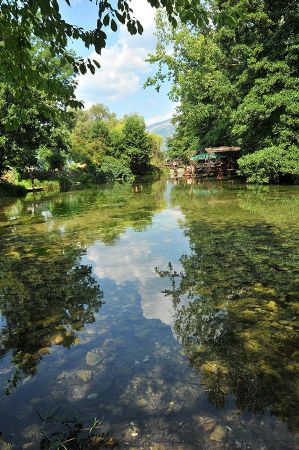 When we took a closer look at the buildings from the water, we were initially a little disappointed because the cross-domed church was almost completely hidden by tall, relatively new parts of the building. After leaving our boat we went through the park, which is home to a magnificent flock of peacocks, into the castle-like monastery building with its large inner courtyard. Now finally the ancient monastery church lay before us in all its splendour.
When we took a closer look at the buildings from the water, we were initially a little disappointed because the cross-domed church was almost completely hidden by tall, relatively new parts of the building. After leaving our boat we went through the park, which is home to a magnificent flock of peacocks, into the castle-like monastery building with its large inner courtyard. Now finally the ancient monastery church lay before us in all its splendour.
The monastery church, a typical three-aisled cross-domed church, is still used for religious purposes today, although the monastery itself has long since ceased its services. The interior of the church itself is full of interesting frescoes depicting scenes from the life of Naum and other Slavic apostles. On the left at the entrance to the monastery, the Bulgarian Tsar Boris I is pictured as the monastery's founder.
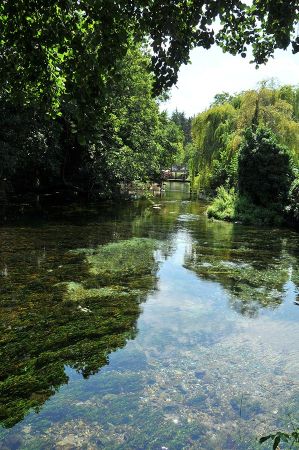 After the tour, we all agreed that the journey from Ohrid to visit the monastery alone would not be worth it if there were no other attractions to see in the immediate vicinity, such as the spring waters of Lake Ohrid, which we would, however, have a separate article for will be dedicated. After our tour we feel increasingly hungry and decide to visit the hotel restaurant in the monastery building. Like almost everywhere in Macedonia, the price-performance ratio is absolutely right and we enjoy our slightly late lunch on the restaurant balcony with a wonderful view over Lake Ohrid.
After the tour, we all agreed that the journey from Ohrid to visit the monastery alone would not be worth it if there were no other attractions to see in the immediate vicinity, such as the spring waters of Lake Ohrid, which we would, however, have a separate article for will be dedicated. After our tour we feel increasingly hungry and decide to visit the hotel restaurant in the monastery building. Like almost everywhere in Macedonia, the price-performance ratio is absolutely right and we enjoy our slightly late lunch on the restaurant balcony with a wonderful view over Lake Ohrid.
Please read as well:
Diving paradise next to pile dwelling Museum on the Water
Misho Yuzmeski - travel guide, writer and photographer
-
 Sveti Naum Monastery at Lake Ohrid
Sveti Naum Monastery at Lake Ohrid
Sveti Naum Monastery at Lake Ohrid
Sveti Naum Monastery at Lake Ohrid
-
 Sveti Naum Monastery at Lake Ohrid
Sveti Naum Monastery at Lake Ohrid
Sveti Naum Monastery at Lake Ohrid
Sveti Naum Monastery at Lake Ohrid
-
 Sveti Naum Monastery at Lake Ohrid
Sveti Naum Monastery at Lake Ohrid
Sveti Naum Monastery at Lake Ohrid
Sveti Naum Monastery at Lake Ohrid
-
 Sveti Naum Monastery at Lake Ohrid
Sveti Naum Monastery at Lake Ohrid
Sveti Naum Monastery at Lake Ohrid
Sveti Naum Monastery at Lake Ohrid
-
 Sveti Naum Monastery at Lake Ohrid
Sveti Naum Monastery at Lake Ohrid
Sveti Naum Monastery at Lake Ohrid
Sveti Naum Monastery at Lake Ohrid
-
 Sveti Naum Monastery at Lake Ohrid
Sveti Naum Monastery at Lake Ohrid
Sveti Naum Monastery at Lake Ohrid
Sveti Naum Monastery at Lake Ohrid
-
 Sveti Naum Monastery at Lake Ohrid
Sveti Naum Monastery at Lake Ohrid
Sveti Naum Monastery at Lake Ohrid
Sveti Naum Monastery at Lake Ohrid
-
 Sveti Naum Monastery at Lake Ohrid
Sveti Naum Monastery at Lake Ohrid
Sveti Naum Monastery at Lake Ohrid
Sveti Naum Monastery at Lake Ohrid
-
 Sveti Naum Monastery at Lake Ohrid
Sveti Naum Monastery at Lake Ohrid
Sveti Naum Monastery at Lake Ohrid
Sveti Naum Monastery at Lake Ohrid
-
 Sveti Naum Monastery at Lake Ohrid
Sveti Naum Monastery at Lake Ohrid
Sveti Naum Monastery at Lake Ohrid
Sveti Naum Monastery at Lake Ohrid
-
 Sveti Naum Monastery at Lake Ohrid
Sveti Naum Monastery at Lake Ohrid
Sveti Naum Monastery at Lake Ohrid
Sveti Naum Monastery at Lake Ohrid
-
 Sveti Naum Monastery at Lake Ohrid
Sveti Naum Monastery at Lake Ohrid
Sveti Naum Monastery at Lake Ohrid
Sveti Naum Monastery at Lake Ohrid
https://www.alaturka.info/en/macedonia/ohrid/6393-shortly-before-the-border-with-albania-monastery-of-sveti-naum?layout=default#sigProIdb4667a2080
